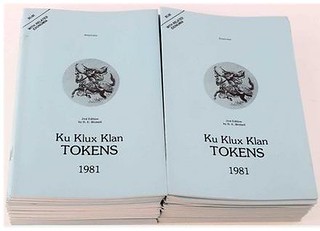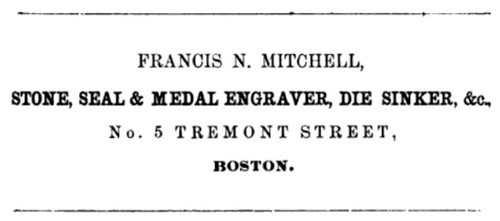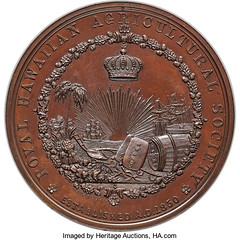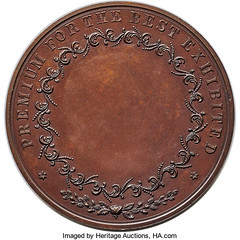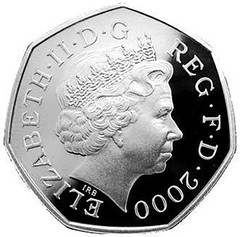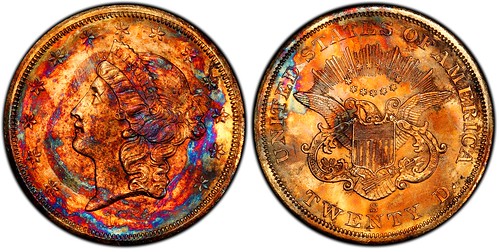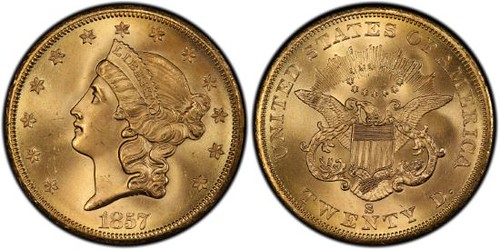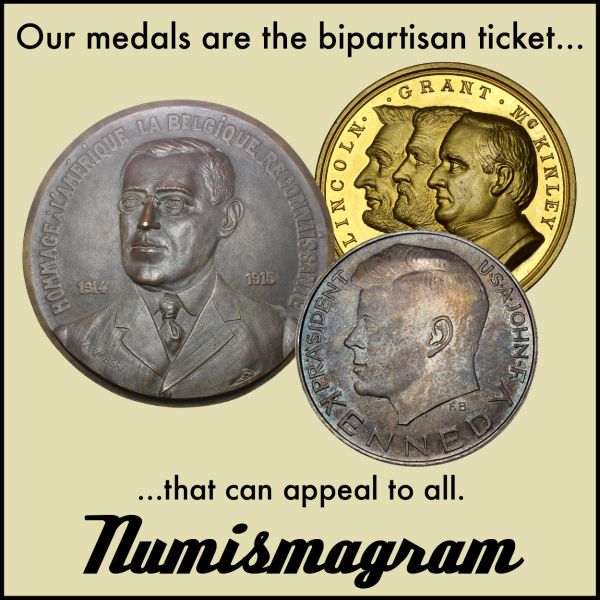
PREV ARTICLE
NEXT ARTICLE
FULL ISSUE
PREV FULL ISSUE
NOTES FROM E-SYLUM READERS: APRIL 30, 2023
KKK Token Book Printing Confirmed
"I don't actually know how to tell the difference, as I never knew there were two printings until the article in The E-Sylum. "I checked the version I have, and all the specific photos mentioned were dark or indistinct, so presumably the first printing. Also I'm assuming (perhaps incorrectly) that the second printing would be stated as such on the title or copyright page." Thanks. Good to have an answer. Rex can be reached at rexstark@yahoo.com . -Editor
To read the earlier E-Sylum article, see:
Robert Gilmor Jr. and Rhonda Guess "I especially enjoyed the dime update, the Roman Hoard discovery, the Viking coins found in Denmark and the New Jersey time capsule. "Pierre Flandin's connection to Robert Gilmor Jr. and Baltimore aroused my curiosity. Because there's a Gilmor Street in the city, I went looking to see what I could find out about him." Jim found some interesting articles related to Gilmore and I passed them on to Joel Orosz. He also confirmed that FNN reporter Rhonda Guess later worked at a Fox News Channel in Chicago, BET, and stations in Texas and California. Thanks! -Editor
1859 Francis Nalder Mitchell Ad "I located a .pdf file of the original Bushnell Historical Account of the First Three Business Tokens Issued in the City of New York. At the end of the very brief document there were a few ads, and I came up with this gem." Thanks. We mentioned Mitchell once before. Does anyone have additional background on him? -Editor Circa 1857 Royal Hawaiian Agricultural Society Medal, Julian AM-24, Medcalf 2RM-5, Harkness HI-30. MS66 Brown NGC. Bronze, 149.4 grams, 64 mm. The obverse has a wreath enclosing the Royal Hawaiian crown and various symbols and implements of Hawaiian agriculture including cotton, sugar, a plow, two ships, and the sun and rays on the ocean horizon, with ROYAL HAWAIIAN AGRICULTURAL SOCIETY / ESTABLISHED A.D. 1850 around, and is signed by Mitchell. The reverse has a wreath enclosing a blank space with the legend PREMIUM FOR THE BEST EXHIBITED. This pristine walnut-brown medal is unawarded. Listed on page 152 of the second (1991) edition of Hawaiian Money Standard Catalog by Donald Medcalf and Ronald Russell. Julian reports that these medals were ordered in 1854, and struck through 1857. They are doubtless extremely rare. This boldly defined representative has lovely mahogany-brown surfaces with no spots or other imperfections. Francis Nalder Mitchell was a distinguished middle-19th century medalist, engraver, and die sinker who worked in Boston in the 1840s to the 1850s. He was born in Edinburgh, Scotland in 1810, and died in Scotland in 1865, having returned there a few years earlier. Among medals attributed to Mitchell are 18 different entries in the Julian reference. Mitchell engraved the award medals for the Massachusetts Charitable Mechanic Association (AM-34 through AM-41). He was selected for a die sinking award in 1850 and received the medal that he had designed.
To read the earlier E-Sylum article, see:
Token and Medal Information Sought "I have found references to two historical medals/tokens that I cannot locate images or any other information on. Perhaps a reader can help! "ca. 1832 during the South Carolina nullification crisis: "South Carolina rang with the rebel yell...Then events turned ominous, for medals were struck bearing the inscription: "John C. Calhoun, First President of the Southern Confederacy." pg 14 of Andrew Jackson and the Course of American Democracy 1833-1845 Vol III Robert V. Remini "Christian Gobrecht "Coin Work... he engraved brass dies for Morocco covers of the Boston Token, also a large eagle with expanded wings for a Philadelphia token." pg 48 The Venus Numismatics Dictionary of Artists...1792-1977 by Francis Pessolano-Filos." Interesting questions - can anyone help? -Editor
New King, New Coins?
"Collectors in this country of a certain age can remember the pre decimal times in the 1970s and earlier when we frequently found coins of George V, George VI, sometimes Edward VII and quite often coins of Victoria in your change. Coins last a long time, perhaps a century or more. Future generations are unlikely to have the delightful experience of finding old coins in their pocket. Perhaps they will not even use coins at all in everyday purchases. "Long ago the coins of some Roman emperors were deliberately defaced and others called, counter stamped overstruck or melted. Forgive my ignorance, but I do not know if colonial coins were called in after the American War of Independence. "The coins of her late Majesty will continue to be enjoyed for years and at the same time we look forward to see what new designs and issues are in store for us. God save our new King." Indeed. Thank you. -Editor
On Doctoring, er, Conserving Coins "I am sure that most of the readers here have seen an episode or two of ANTIQUES ROAD SHOW. Very often, the experts will tell the owner of a painting (but not for wood furniture) to clean the canvas, increasing the value. They usually mention that by doing so, will increase the potential value of the item 10-20-30%. "Then WHY is it considered WRONG to clean a coin, to repair a light damage (rim nick for example). By doing so, the item will no longer be easy to sell and the value will DECREASE substantially. I just do not understand. Can someone, anyone explain this to me ? "Every time I watch it, I ask myself then why is cleaning a coin (and remember that dealers such as me with years of experience) know how to clean a coin properly and not screw it up, like with toothpaste, pencil eraser, or harsh chemicals. We have learned what is attractive and what is not. To mention that a coin more than 100 years old has been cleaned or has light damage, like evidence of a mount mark and is therefore worth less, is just plain wrong (IMHO). The vast majority of European Talers for example are generally not perfect, as eye appeal should override whether a Mount mark is present." We've discussed this topic before, but it's always worth revisiting. The answer typically depends on who's talking, who's doing the work and how well they do it. Your coin has been "doctored". My coin has been "conserved." You and they are ham-handed butchers who ruin nice coins, but my guy is a careful professional. I have every confidence in my friend Bob Evans who carefully conserved most of the coins recovered from the wreck of the S.S. Central America. This work hasn't affected their market value one whit. Other coins and paper money doctored by persons unknown? Debatable. In the images below, the first coin has deliberately not been conserved because the toning is pleasant. Others came out of the drink much worse looking. After conservation they were beautiful. -Editor
Wayne Homren, Editor The Numismatic Bibliomania Society is a non-profit organization promoting numismatic literature. See our web site at coinbooks.org. To submit items for publication in The E-Sylum, write to the Editor at this address: whomren@gmail.com To subscribe go to: https://my.binhost.com/lists/listinfo/esylum All Rights Reserved. NBS Home Page Contact the NBS webmaster 
|
